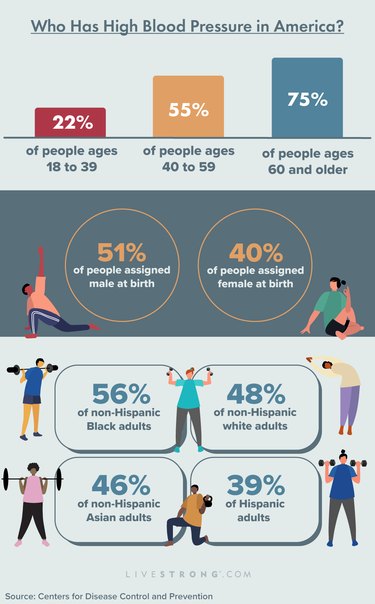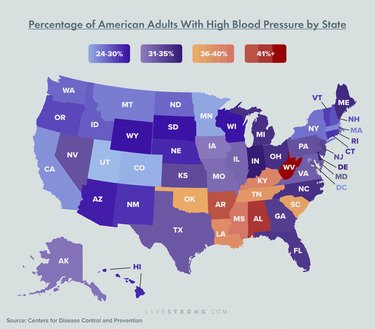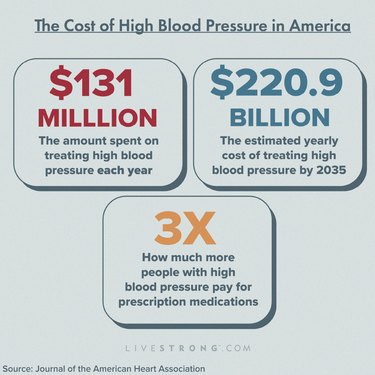
There's a reason high blood pressure is called the "silent killer." Not only is high BP a risk factor for heart disease, but oftentimes, there are no warning signs or symptoms of the condition, which can develop stealthily, over time.
In fact, even though high blood pressure affects nearly half of all adults in the United States, an estimated 1 in 3 people don't know they have it — and therefore, aren't being treated for it, according to the Centers for Disease Control and Prevention (CDC).
Video of the Day
Video of the Day
The problem: Left untreated, high BP can lead to heart attack, stroke, vision loss, kidney disease, sexual dysfunction and more. The only way to know if your numbers are too high is by getting your blood pressure measured.
The most accurate way to learn your BP is to have your doctor check it. You can also check your numbers with an at-home blood pressure monitor, though these may devices can become inaccurate, so it's always best to confirm your reading at the doctor's office.
The good news is there are ways to control your blood pressure, either with medication or lifestyle changes. Read on to learn more high blood pressure statistics.
What Is High Blood Pressure?
High blood pressure (hypertension) occurs when blood flows through your blood vessels with too much force. Doctors measure BP using two numbers: The top (systolic) measures the pressure when the heart beats, and the bottom (diastolic) measures the pressure when the heart rests between beats, according to the American Heart Association (AHA). Here's a breakdown of those numbers:
- Healthy blood pressure is lower than 120/80 millimeters of mercury (mm Hg)
- Elevated blood pressure is between 120/80 mm Hg and 129/80 mm Hg
- Stage 1 high blood pressure is 130/80 mm Hg to 139/89 mm Hg
- Stage 2 high blood pressure is 140/90 mm Hg or higher
- Hypertensive crisis is 180/120 mm Hg or higher
Hypertension Statistics Worldwide
High blood pressure is the biggest global risk factor for heart disease and chronic kidney disease, according to a November 2016 study in The Lancet. While blood pressure levels in high-income countries have dropped over the past 40 years, blood pressure levels are rising in people who live in low-income countries, particularly those in South Asia and sub-Saharan Africa.
Here are more statistics about how high blood pressure affects people worldwide.
- Globally, about 1.13 billion people have high blood pressure (as defined by 140/90 mm Hg), according to the World Health Organization (WHO).
- About 1 in 5 people assigned female at birth have high blood pressure.
- About 1 in 4 people assigned male at birth have high blood pressure.
High Blood Pressure Statistics by Region
According to the WHO, high blood pressure of 140/90 mm Hg affects:
- 27% of people in Africa
- 26% of people in the Eastern Mediterranean
- 25% of people in Southeast Asia
- 23% of people in Europe
- 19% of people in the Western Pacific
- 18% of people in the Americas
Hypertension Demographics for the United States

Adults With High Blood Pressure
Nearly half of all American adults have high blood pressure (as defined by 130/80 mm Hg or higher). Here's what that looks like in the U.S., according to the CDC:
- About 108 million adults — 45% of the population — have high blood pressure or are taking medication for high BP.
- Only 1 in 4 adults with high blood pressure have their condition under control.
- About 37 million adults with uncontrolled high blood pressure have a reading of 140/90 mm Hg or higher.
Hypertension Prevalence by Age
The risk for high blood pressure increases as people get older, according to the CDC, affecting:
- 22.4% of people ages 18 to 39
- 54.5% of people ages 40 to 59
- 74.5% of people 60 and older
High Blood Pressure Prevalence by Sex
People assigned male at birth (AMAB) are more likely to have high blood pressure than people assigned female at birth (AFAB), according to the CDC. In the U.S., high BP affects:
- 51% of people AMAB
- 39.7% of people AFAB
Hypertension and Race Statistics
In the U.S., Black adults have the highest rates of high blood pressure and are also more likely to be hospitalized for the condition, per the CDC. According to CDC statistics, high blood pressure occurs in:
- 56% of non-Hispanic Black adults
- 48% of non-Hispanic white adults
- 46% of non-Hispanic Asian adults
- 39% of Hispanic adults
Hypertension Statistics by State

Of the 50 states in the U.S., Utah has the lowest percentage of adults with high blood pressure (24.5%), while West Virginia has the highest percentage (43.5%), according to the CDC. Here's a breakdown of the percentage of people with high blood pressure by state (including Washington, D.C.).
- Alabama: 41.9%
- Alaska: 31.8%
- Arizona: 30.7%
- Arkansas: 41.3%
- California: 28.4%
- Colorado: 25.9%
- Connecticut: 30.5%
- Delaware: 34.9%
- District of Columbia: 26.7%
- Florida: 34.6%
- Georgia: 33.1%
- Hawaii: 30.6%
- Idaho: 29.8%
- Illinois: 32.3%
- Indiana: 35.2%
- Iowa: 31.5%
- Kansas: 32.8%
- Kentucky: 39.4%
- Louisiana: 39%
- Maine: 34.8%
- Maryland: 32.4%
- Massachusetts: 28.6%
- Michigan: 34.7%
- Minnesota: 26.6%
- Mississippi: 40.8
- Missouri: 32%
- Montana: 29%
- Nebraska: 30.6%
- Nevada: 32.6%
- New Hampshire: 30%
- New Jersey: 33%
- New Mexico: 30.5%
- New York: 29.4%
- North Carolina: 34.7%
- North Dakota: 29.5%
- Ohio: 34.7%
- Oklahoma: 37.7%
- Oregon: 30.1%
- Pennsylvania: 32.6%
- Rhode Island: 33.1%
- South Carolina: 38.1%
- South Dakota: 30.8%
- Tennessee: 38.7%
- Texas: 32.5%
- Utah: 24.5%
- Vermont: 30.4%
- Virginia: 32.4%
- Washington: 29.5%
- West Virginia: 43.5%
- Wisconsin: 30.8%
- Wyoming: 30.8%
High Blood Pressure Prevalence During Pregnancy
Hypertension during pregnancy is becoming more common in the U.S., affecting about 1 in every 12 to 17 pregnancies among people ages 20 to 44, according to the CDC.
The complications of high BP during pregnancy include preeclampsia and eclampsia as well as preterm delivery.
High Blood Pressure Statistics in Children
Adults aren't the only ones affected by high blood pressure — children can develop it, too. Here are some high BP statistics in kids, according to a March 2020 report in the journal Circulation.
- About 11 percent of children ages 8 to 17 have high blood pressure or borderline high blood pressure.
- High blood pressure is more common among boys (1.8%) than girls (1.4%).
- High blood pressure is more common among Hispanic children (2.4%) than non-Hispanic Black children (1.9%), non-Hispanic Asian children (1.7%) or non-Hispanic white children (1.1%).
High Blood Pressure Complications and Management Data for the U.S.
Here are the stats on high blood pressure complications and treatment:
Stats on Hypertension Complications
High blood pressure can damage your heart, brain, kidneys and eyes and increase your risk not only for hospitalizations, but for other diseases, too. Here are some statistics about high blood pressure complications.
- About 6 out of 10 people who have diabetes also have high blood pressure, according to the CDC.
- People with hypertension develop heart disease about 5 years earlier than people without high blood pressure, according to the 2020 report in Circulation.
- About 1 million of the emergency room visits in 2016 were for problems related to high blood pressure.
Mortality Rate of Hypertension
High blood pressure can increase the risk for heart disease and stroke, which are two of the most common causes of death for people in the United States.
- High blood pressure caused — or contributed to — more than 494,873 deaths in the United States in 2018, according to the CDC.
- If no one had high blood pressure, deaths from cardiovascular disease could fall by an estimated 30% in men and 38% in women, according to the 2020 Circulation report.
High Blood Pressure Management Stats
High blood pressure can be managed with medication, lifestyle changes or both. Here's what people in the U.S. are doing to manage their BP levels.
- 91.7 million Americans need to take prescription medication and make lifestyle changes to lower their BP levels, according to Million Hearts, an initiative to prevent heart attacks and strokes from the CDC.
- 24.3 million Americans need to make lifestyle changes to lower their blood pressure.
- 33.6 million Americans who are already being treated for hypertension may need to have their medication adjusted to get their BP under control.
- About 1 in 2 adults who have high blood pressure report using a blood pressure monitor at home to keep tabs on their levels, according to a 2017 paper in The Journal of Clinical Hypertension.
- Older adults are more likely to use a monitor than younger adults: About 63% of people ages 65 and older do, compared to 51% of people ages 35 to 64 and 34.6% of people ages 18 to 34.
The Cost of High Blood Pressure in America

Treating high blood pressure in the U.S. costs about $131 billion — or more than 3% of the $3 trillion national health care expenses, according to a June 2018 study in the Journal of the American Heart Association.
In particular, people with high blood pressure pay about $2,000 more each year in health care costs than people without high blood pressure, including:
- 2.5 times as much for inpatient care
- Twice as much for outpatient care
- Triple the amount for prescription medications
By 2035, the total direct costs of treating hypertension could increase to an estimated $220.9 billion.
- The Lancet: "Worldwide Trends in Blood Pressure From 1975 to 2015: A Pooled Analysis of 1479 Population-based Measurement Studies With 19.1 Million Participants."
- World Health Organization: "Hypertension: Act Now!"
- World Health Organization: "Hypertension Prevalence by WHO Region"
- Centers for Disease Control and Prevention: "Hypertension Prevalence Among Adults Aged 18 and Over: United States, 2017-2018"
- Centers for Disease Control and Prevention: "Facts About Hypertension"
- Centers for Disease Control and Prevention: "Prevalence of Hypertension Among US Adults (18+); BRFSS"
- Circulation: "Heart Disease and Stroke Statistics: 2020 Update: A Report From the American Heart Association"
- Centers for Disease Control and Prevention: "High Blood Pressure During Pregnancy"
- Centers for Disease Control and Prevention: "Know Your Risk Factors for High Blood Pressure"
- Million Hearts: "Estimated Hypertension Prevalence, Treatment, and Control Among U.S. Adults"
- The Journal of Clinical Hypertension: "Home Blood Pressure Monitoring Among Adults - American Heart Association Cardiovascular Health Consumer Survey, 2012"
- Journal of the American Heart Association: "Trends in Healthcare Expenditures Among US Adults With Hypertension: National Estimates, 2003-2004"
- American Heart Association: "Understanding Blood Pressure Readings"
- Centers for Disease Control and Prevention: "5 Surprising Facts About High Blood Pressure"
Is this an emergency? If you are experiencing serious medical symptoms, please see the National Library of Medicine’s list of signs you need emergency medical attention or call 911.